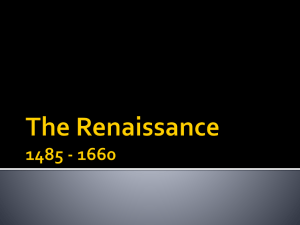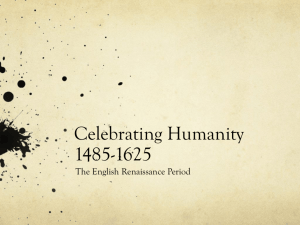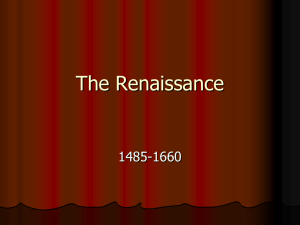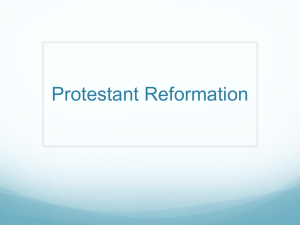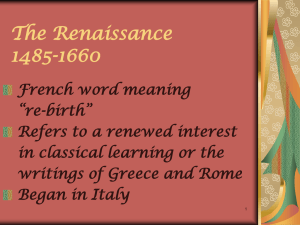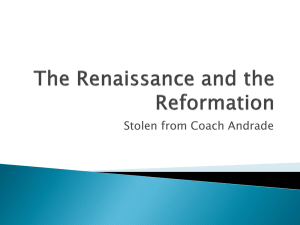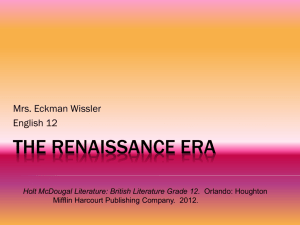The Renaissance
advertisement
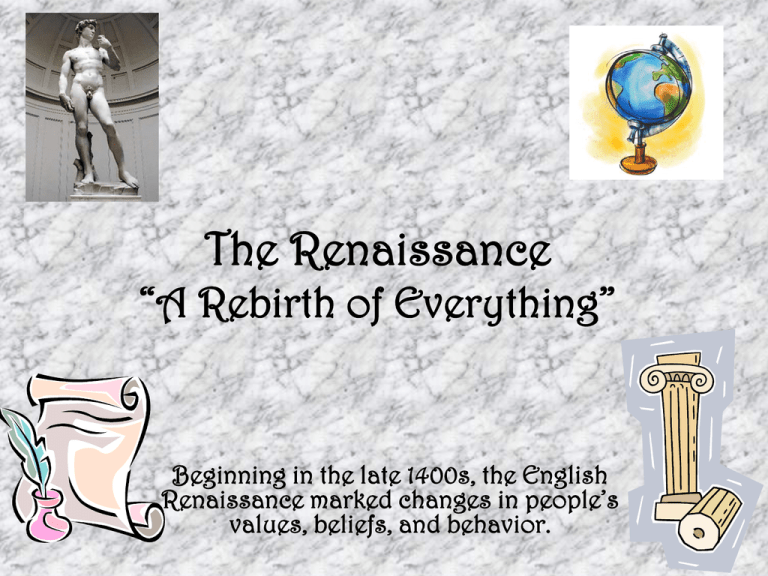
The Renaissance “A Rebirth of Everything” Beginning in the late 1400s, the English Renaissance marked changes in people’s values, beliefs, and behavior. Rediscovering Ancient Greece and Rome • “Renaissance” – translated as “rebirth” – Renewed interest in classical learning • Writings of ancient Greece and Rome – Found knowledge in books hidden away in monasteries for hundreds of years – People became more curious about themselves and the world around them – Renewal of the human spirit- curiosity& creativity Names for the Time Period • Renaissance – Rebirth of the classics • Age of Exploration – Exploring new lands – Ex. – Columbus, Raleigh, Cabot • Age of Discovery – Discovering new inventions and sciences – Ex. – daVinci, Copernicus, Galen • Reformation – Martin Luther • Elizabethan Era – Queen Elizabeth I’s reign Renaissance Man • An energetic & productive human being who is interested in science, literature, history, art, and other subjects. – Examples: Henry VIII, Leonardo daVinci Thomas Jefferson It all Began in Italy: Italian Renaissance • Began in Italy in 14th century – 16th century • Wealth generated from banking & trade with the East – Example: Venice Leonardo daVinci Michelangelo Bonarati Galileo Galilei Raphael Christopher Columbus Religion • Almost everyone in Europe and Britain was Roman Catholic – Church was rich a powerful in religious and political affairs – Popes were patrons of artists, architects, and scholars • Pope Julius II – Michelangelo and Sistine Chapel – Vatican City – “Pope’s City” Sistine Chapel Humanism • Definition: Intellectual movement. Humanists went to old Latin & Greek classics to discover answers to question like – What is a human being? – What is a good life? – How do I lead a good life? • Sought to harmonize the Bible with the classics – Used the classics to strengthen Christianity Humanism continued… • Plutarch – Aim of life is to attain virtue, not success or money or fame • Made subjects related to classical education (history, literature, and philosophy) popular again • These subjects are called the humanities Two Friends -Two Humanists: Erasmus • Erasmus (1466?-1536) Best-known Renaissance Humanist – Dutch monk who lived outside the monastery – loved to travel – Taught at Cambridge University – Became friends with Thomas More Two Friends -Two Humanists: Thomas More • Lord Chancellor under Henry VIII • Wrote in Latin poem, pamphlets, & biographies • Wrote Utopia – Analyzes the social, economic, penal, and moral problems in England, then describes an ideal, nonexistent society where these problems do not exist. • A Man for All Seasons- Play by Robert Bolt about More’s tragic standoff with King Henry VIII – He would not recognize Henry as the head of the Church of England – He was beheaded The New Technology: A Flood of Print • Printing press transformed the way information was exchanged during the Renaissance. – Before- all books were copied by hand • Johannes Gutenberg (German) – invented the movable-type printing press – 1st complete book – Latin Bible printed in Mainz, Germany (1455) The Reformation: Breaking with the Catholic Church • Reformation- Movement fueled by a group of reformers who rejected the authority of the pope and Italian churchmen. – Pope Paul III (Council of Trent -1545) • Used to investigate selling of indulgences or religious pardons, and other abuses The Reformation: Breaking with the Catholic Church • 1530- Open break with the Roman Catholic Church could not be avoided – Strong feelings of patriotism made English people resent financial burdens imposed on them by the Pope. – New religious ideas were coming to England from Germany – Martin Luther The Reformation: Breaking with the Catholic Church • Martin Luther (1483-1546) Founded new kind of Christianity, not based on what the Pope said, but on a personal understanding of the Bible. – Lutheran Church – 95 Theses – was a list of complaints against the Catholic Church that was nailed to the door of a church in Wittenberg, Germany The Reformation: Breaking with the Catholic Church • Humanists ridiculed old superstitions, ignorance, and idleness of monks and loose living and personal wealth of priests and bishops. King versus Pope: All for an Heir • King Henry VIII had six wives: – He was first married to Catherine of Aragon (a Spanish Roman Catholic) – Married for 24 years – She could not produce a male heir • Only Mary ( a Catholic daughter) – to become “Bloody Mary” • Henry asked Pope Clement II to declare that he and Catherine were not properly married – She was previously married to Henry’s brother Arthur for only 5 months before he died. • He got his religious advisors to dig up Biblical evidence in Leviticus that it was unlawful to marry a dead brother’s spouse. Henry VIII: Renaissance Man and Executioner • There were five Tudor rulers in England – Henry’s grandfather, father, and three children • Grandfather- Henry VII- Welsh nobleman who seized the throne after England was totally exhausted by the Wars of the Roses (began in 1455) – Battle for the crown between the » Lancaster (white rose) » York (red rose) King Henry VIII • He was a coarse, arrogant womanizer • At an early age he was a “Renaissance Man” – Very attractive, athletic, and intelligent • Henry could cheat on his wives but would not tolerate infidelity from them – Anne Boleyn and Katherine Howard • He did create the Royal Navy – put a stop to foreign invasions Henry VIII had Six Wives (1509-1547) • Catherine of Aragon – Roman Catholic from Spain – He divorced her; she died of natural causes – Children – Mary (Catholic) • Anne Boleyn – – – – – Lady-in-Waiting of Catherine of Aragon Very bright, spirited, and beautiful Believed in the Reformation Beheaded when Henry grew tired of her Children – Elizabeth (Protestant) Henry VIII had Six Wives (1509-1547) • Jane Seymour – – – – Lady-in-waiting to Anne Boleyn Gentle, modest, and obedient Died after birth of … Children – Edward (sickly boy – died of TB early) • Anne of Cleves – Sister of the German ruler – Did not speak English – Henry thought she was ugly; he agreed to marry her sight unseen – She agreed to a divorce and an anullment – Children - none Henry VIII had Six Wives (1509-1547) • Katherine Howard – Cousin of Anne Boleyn – 15 or 16 when she married Henry – After her marriage to the king, she resumed a relationship with an “old flame” • She was discovered and arrested • She was executed – Children - none Henry VIII had Six Wives (1509-1547) • Katherine Parr (Lady Jane Grey) – She was in love with Jane Seymour’s brother, Thomas but dared not refuse the King – Acted as a nurse to Henry in his old age – Good to his children and helped him reconcile with Catherine of Aragon’s daughter, Mary – Henry died on January 28, 1547. Within months she married her true love, Thomas Seymour – She died of complications from childbirth in 1548 – Children - none Reasons for Divorce • Catherine bore him only one living child – A daughter (Mary) – She was too old to bare him any more children (esp. a son) – She had lost 5 children previously • Anne Boleyn (one of Catherine’s ladies in waiting) caught his eye and she would not have sex with him unless they were married – She used this to “play hard to get” for a while King versus Pope: All for an Heir • Divorce was not allowed according to the Catholic Church – Especially with the royalty (until recently in Britain with Charles and Diana) – Pope refuses to grant Henry’s request -1533 • Henry declares himself head of the Church of England – Appoints an Archbishop of Canterbury (as the head of the Church in England) and he declared Henry and Catherine’s marriage invalid. King versus Pope: All for an Heir • Catherine refuses to accept the annulment of their marriage – She is put under house arrest in the Tower of London and out of Henry’s sight • Henry closes all monasteries and sells the riches, buildings, and lands to his subjects. King versus Pope: All for an Heir • This is the beginning of Protestantism in England – People thought the Church was not reformed enough – They thought it was merely a copy of Catholicism • These people were the Puritans, Presbyterians, etc. • Wanted to get rid of things considered “Popish” – Bishops, prayer books, priests’ vestments, church bells, stained glass, etc. Henry’s Children Become Monarchs • Henry was survived by 3 children – Mary – Daughter of Catherine of Aragon • Catholic – Elizabeth – Daughter of Anne Boleyn • Protestant – Edward – Son of Jane Seymour Was crowned at age 9 after his father’s death • Was a sickly boy, ruled in name only • Died of tuberculosis Mary Becomes Queen 1553-1558 • Strong-willed, devout Catholic • ½ Spanish • Wanted to avenge wrongs done to her mother – Ruthlessly hunted down Protestants • Burned approximately 300 at the stake for their faith – Hence the nickname “Bloody Mary” • Married King Phillip II of Spain (she was older) • She died of a “fever” and childless • After her death, her sister Elizabeth becomes queen. Elizabeth: The Virgin Queen 1558-1603 • One of the most brilliant & successful monarchs in history • Her 1st task- restore law and order after Mary’s reign – Re-established Church of England – Rejected the Pope’s authority • He excommunicated her • To keep Spain happy, she pretended she might marry her widowed brother-in-law Phillip of Spain Elizabeth: The Virgin Queen 1558-1603 • Resisted marriage all of her life, but she had several lovers – Robert Dudley, Earl of Leicester – Robert Devereux, Earl of Essex • “Virgin Queen” – she became so tired of her advisors trying to force her to marry in order to beget an heir and secure her throne that she refused altogether. – Cut off her hair, painted her skin white, and declared herself the “Virgin Queen,” married to England This gave Virginia its name Elizabeth: The Virgin Queen 1558-1603 • She survived many plots against her life – Many by her cousin, Mary Stuart, Mary Queen of Scots • Elizabeth did not have children and Mary was heir to England’s throne because she was a direct descendant of Henry VIII • As a Catholic, Mary was deposed of her throne in Protestant Scotland • Elizabeth enduring Mary’s plots for 20 years, then was forced by Sir Francis Walsingham to execute her – Did not wish to kill Mary because Mary was a “God anointed sovereign” and her kin The Spanish Armada Sinks: A Turning Point in History • King Phillip of Spain used Mary, Queen of Scots’ execution as an excuse to invade England. • He assembled a fleet of warships – Spanish Armada – 1558-England’s Royal Navy destroyed the Armada • Assured England’s and all of northern Europe’s independence form powerful Catholic countries of the Mediterranean • If Spain had won, North and South American would be speaking Spanish, not English. “I know I have the body of a weak and feeble woman, but I have the heart and stomach of a king, and of a king of England too.” Flood of Literature • Religion and national identity started England writing as never before. • Elizabeth was a symbol of peace, security, & prosperity to her subjects. – Inspired authors • • • • Gloriana Diana The Faerie Queene Cynthia Decline of the Renaissance • Elizabeth dies without an heir • Her 2nd cousin, James IV of Scotland, becomes king (1603-1625) – Son of Mary, Queen of Scots – Wrote books about the Divine Right of Kings & against the use of tobacco – Patron of Shakespeare (King’s Men) – Sponsored an English translation of the Bible • King James Bible – Benevolent ruler; had problems with pious puritanical-minded merchants The Renaissance Begins to Wane • Charles I (James’ son) becomes king – Self-destructive ruler • His powerful subjects had him beheaded in 1649 • England was ruled by Parliament and a Puritan dictator, Oliver Cromwell, for the next 11 years • Charles II (Charles I son) returns from exile in France • Milton is the last great writer of the Renaissance – Paradise Lost • English Renaissance ends
